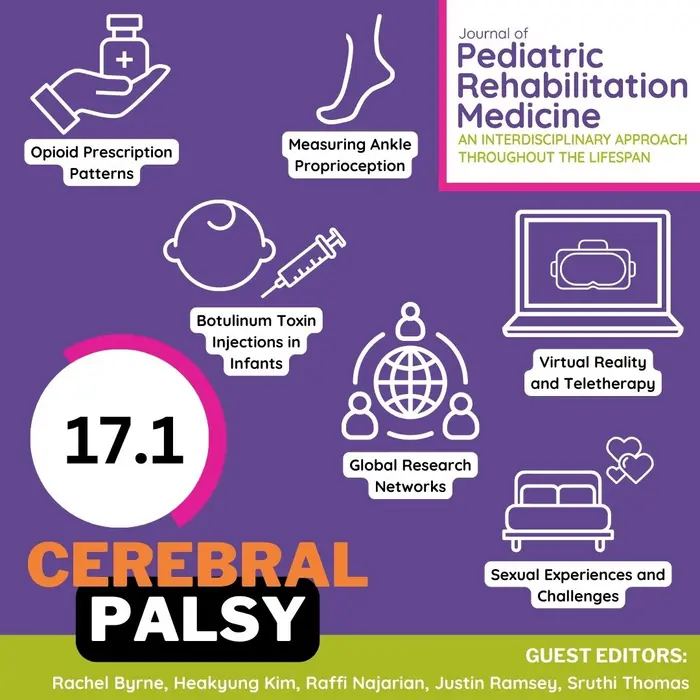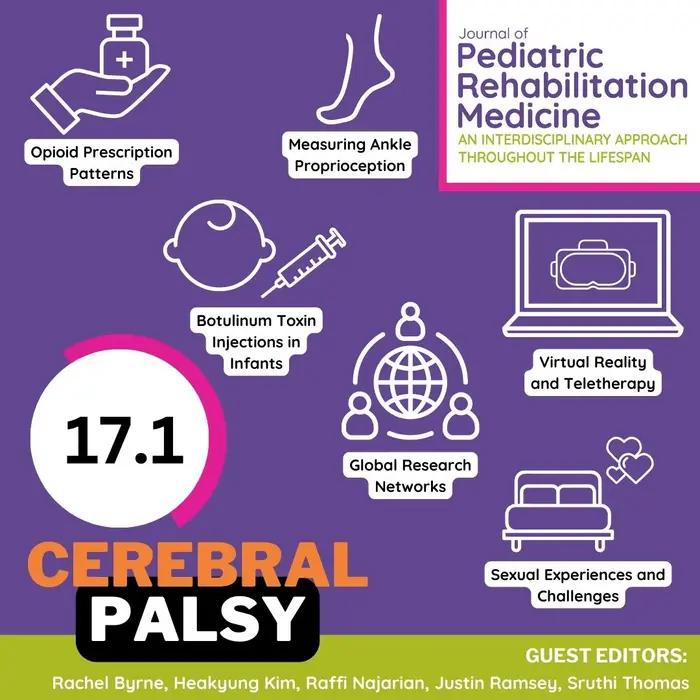Increased lifespan of individuals living with cerebral palsy necessitates a broader perspective on care
Amsterdam, June 6, 2024 – Because the majority of people living with cerebral palsy (CP) are adults, a focus on adult care in addition to pediatric and adolescent care is increasingly important to address their needs. A special issue of the Journal of Pediatric Rehabilitation Medicine, published by IOS Press, highlights topics associated with CP […]

Amsterdam, June 6, 2024 – Because the majority of people living with cerebral palsy (CP) are adults, a focus on adult care in addition to pediatric and adolescent care is increasingly important to address their needs. A special issue of the Journal of Pediatric Rehabilitation Medicine, published by IOS Press, highlights topics associated with CP across the spectrum of life, including issues surrounding mental health, sexuality, and independence.

Credit: Journal of Pediatric Rehabilitation Medicine
Amsterdam, June 6, 2024 – Because the majority of people living with cerebral palsy (CP) are adults, a focus on adult care in addition to pediatric and adolescent care is increasingly important to address their needs. A special issue of the Journal of Pediatric Rehabilitation Medicine, published by IOS Press, highlights topics associated with CP across the spectrum of life, including issues surrounding mental health, sexuality, and independence.
Guest Editor Rachel Byrne, PT, Cerebral Palsy Foundation, New York, NY, says, “Emerging evidence highlights the critical significance of mental health and combating social isolation in the care of individuals with CP and similar physical disabilities. However, these crucial aspects have historically been underfunded and therefore sidelined in clinical programs. Enhanced training at specialty and primary care levels is urgently needed to address these gaps. The absence of informed adult care stands out as one of the foremost challenges patients encounter and needs immediate attention.”
“One of the most significant challenges is treating CP across the spectrum of life. This includes issues such as independence, adult complications, and secondary prevention. Perhaps one of the biggest barriers is that CP is defined as a pediatric condition in many individuals’ minds. Approximately 60% of individuals with CP are adults,” adds co-Guest Editor Justin W. Ramsey, MD, Bethany Children’s Health Center, Bethany, OK.
The article “Exploring the sexual experiences and challenges of individuals with cerebral palsy” investigates experiences, challenges, and related factors surrounding sexuality and intimacy that people with CP are facing. Lead investigator and co-Guest Editor Heakyung Kim, MD, Department of Physical Medicine and Rehabilitation, University of Texas Southwestern Medical Center, Dallas, TX, notes, “CP is a prevalent motor disorder affecting children, with evolving demographics indicating an increasing survival into adulthood. This shift necessitates a broader perspective on CP care, particularly in addressing the often-overlooked aspect of sexuality.”
“We wanted to shift the lens of this year’s CP special issue to topics that are often underrepresented in CP research, but matter to individuals with CP a great deal, often more so than the classic hypertonia and gait topics,” comments co-Guest Editor Sruthi Pandipati Thomas, MD, PhD, Texas Children’s Hospital, Houston, TX.
“Individuals with disabilities comprise approximately 13% of the overall population. Our editorial “Medical delivery without representation?: Examining disability representation within the healthcare community” focuses on recent events that may involve ableism. We highlight the deficits and biases inherent within the healthcare field and explore ways to correct the problem. In a time of medical scarcity, it is so important to make sure that individuals with physical and intellectual impairments have a voice,” says co-Guest Editor Christopher Raffi Najarian, MD, MPH, Akron Children’s Hospital, Akron, OH.
The article “Management and treatment of musculoskeletal problems in adults with cerebral palsy: Experience gained from two lifespan clinics” looks at orthopedic experiences in care for adult patients with CP. CP’s musculoskeletal manifestations are progressive due to the long-term effects of spasticity, dystonia, and asymmetric biomechanical forces on the musculoskeletal system. The authors highlight the need for future research to focus on the long-term outcomes of orthopedic surgeries and advocate for a more systematic approach to the assessment and treatment of musculoskeletal issues in adults with CP.
Other articles in this special issue cover the following topics:
- Adaptive designs
- Global research networks
- Opioids
- Pain management
- Botulinum toxin injections
- Kinesthesia
- Teletherapy
- Gross motor function
- Virtual reality-based treatment
- Apnea
- Muscle spasticity
- Lived experience
JPRM Editor-in-Chief Elaine Pico, MD, UCSF Benioff Children’s Hospital Oakland, comments, “This is an exceptionally interesting issue because we have explored issues of aging with CP and perhaps touched on aspects that had not been reported on before in this way. It has been gratifying to work with new special Guest Editors and to have Heakyung Kim sharing her expertise from previous issues with a new editorial team. We are extremely proud of what this robust issue brings to the CP community, providing educational and thought-provoking information.”
Journal
Journal of Pediatric Rehabilitation Medicine
DOI
10.3233/PRM-240013
Method of Research
Experimental study
Subject of Research
People
Article Title
A special issue of the Journal of Pediatric Rehabilitation Medicine on cerebral palsy explores issues of aging with cerebral palsy and reports on often overlooked topics
Article Publication Date
6-Jun-2024
What's Your Reaction?

































